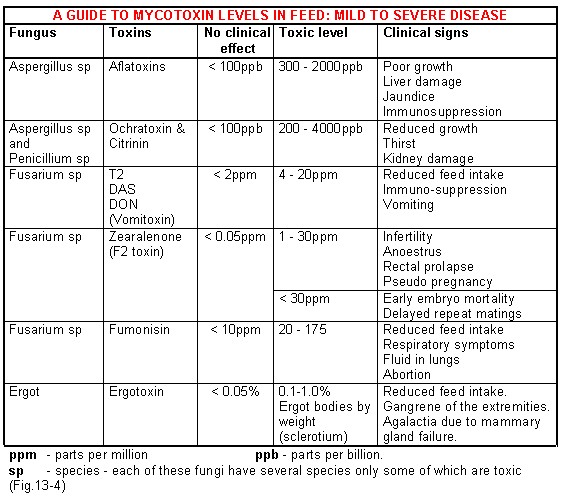



Mycotoxins
Under certain conditions fungi multiply on cereals, corn, cotton seed and other food materials sometimes producing chemicals called mycotoxins (Fig.13-4). They require adequate moisture, oxygen and carbohydrates to multiply and temperatures from 10ºC to 25ºC (50ºF to 77ºF). Multiplication may still take place however outside these ranges and crops that are already diseased are more likely to succumb to fungal infection. The presence of fungi including recognised toxic species however does not necessarily mean that the toxins are present. Each requires precisely the right substrate and environmental conditions to produce toxins. The common fungi causing disease (mycotoxicosis) in the pig include species of Fusarium, Aspergillus and Penicillium, but because of the variable requirements for growth and toxin production particular species tend to predominate in certain geographical areas. Toxins are not destroyed by heating but modern treatments used in the processing of animal feeds such as temperature and pressure may reduce the actual fungal load.
Factors that may increase the likelihood of mycotoxins in feed
- Cereals left over after screening.
- Damaged or broken grains.
- Storage of moist grain.
- Storage in warm damp conditions.
- Damaged leaking feed bins.
- Fluctuating environmental temperatures.
- Fungal growth in liquid feeding systems.
Diagnosis of mycotoxicosis
This can often be frustrating because although the clinical signs may be suggestive they are rarely diagnostic. It may be impossible to detect the toxin in the feed because of patchy distribution and/or the samples taken are toxin free. Also the effect of the toxin may have been delayed and the feed containing the toxin has been consumed. Alternatively the laboratory may be testing for the wrong toxin.
Effects of mycotoxins
The specific effects of the various toxins on the pig are shown in Fig.13-4. Fusarium species require high levels of moisture and relative humidity (>88%) for multiplication and toxin production whereas Aspergillus and Penicillium multiply at lower levels.
Aflatoxins and some of the ochratoxins are immuno-suppressive and can enhance effects of generalised disease.
Methods of preventing mycotoxicosis
- Wherever a fungal toxin is suspected consider the following actions:
- Immediately replace the feed or cereal sources by alternate ones.
- Examine carefully the meal or pellets for evidence of fungi.
- Empty all feed bins out and examine for bridging of feed or presence of mouldy feeds. If feed bins are contaminated, empty them and treat with a non toxic fungicide.
- Examine all automatic equipment and in particular feed hoppers and automatic dispensers for evidence of mouldy feed.
- If wet moist grain is stored, mould inhibitors such as propionic acid, calcium propionate or sorbic acid will prevent growth.
- Once mycotoxins have developed in feed there are no methods that can destroy them. However their effects can be mitigated by regrinding the feed and mixing with an alternate source at a ratio of 1:10 and feeding to growing stock on a test basis first.
- A feed sample should be sent to a laboratory for examination (see chapter 15 Sampling Feeds).
- Check other sources of poisoning, including straw and wet bedding materials.







